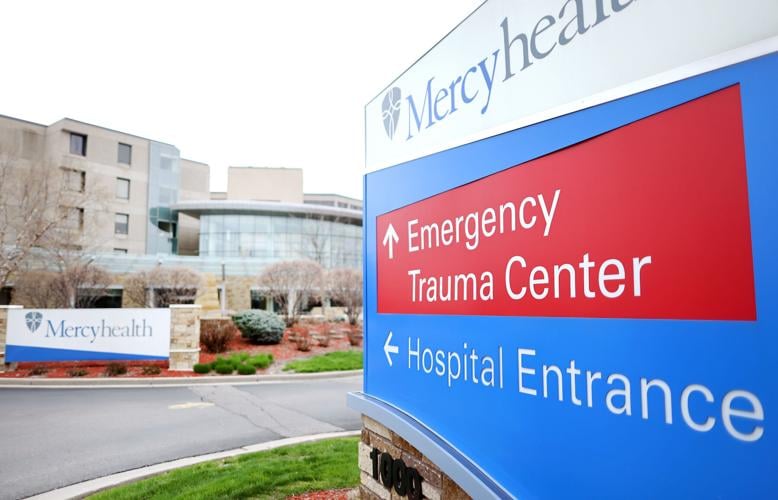JANESVILLE
Under a rule change by a medical accreditation group, Mercyhealth’s Janesville trauma center later this will drop from a “Level II” rating to a “Level III” trauma center.
And while Mercyhealth officials say that shift signals no tangible changes in services to patients with severe injuries or critical emergency conditions, it’s the second significant change that’s come this year within the Janesville-based hospital system’s trauma and emergency medical services support division.
The change comes after Mercyhealth on April 1 made a related but separate move to sideline its Rock County MD-1 vehicle—an SUV equipped with medical and communication equipment that is staffed by a Mercyhealth doctor who can provide physician-level field support to local ambulance crews on critical calls.
MD-1 crews continue to operate in support of local EMS and Mercyhealth’s own trauma centers in Walworth County; Rockford, Illinois; and parts of Chicago’s northwestern suburbs. Janesville’s MD-1 vehicle had been in service and staffed by a doctor full time since 2013.
Chris Wistrom, Mercyhealth’s interim director of emergency medical services, said Mercyhealth now is wrestling with a forced rule change that has come down this year from the American College of Surgery. He said the agency now requires hospitals designated as Level II trauma centers to employ multiple, around-the-clock interventional radiologists who can respond to an emergency within 30 minutes. Interventional radiologists are specialists who use radiology as a surgical tool that can stop hard-to-reach internal bleeding found in trauma patients.
“It basically means they need to be here at the hospital 24 hours a day, seven days a week, 365 days a year, to meet that rule,” Wistrom said.
Dip in demand, tough hiring
Wistrom said Mercyhealth’s Janesville trauma center has never staffed an around-the-clock, in-house interventional radiologist, and amid a labor shortage that has hit the medical community hard, he said Mercyhealth and many other Level II trauma centers around the U.S. might have trouble recruiting and hiring more such specialists quickly.
The Janesville trauma center has used an intervention radiologist infrequently; it has needed such services in just two trauma center procedures over the last five years, Wistrom said.
Still, the fact Mercyhealth doesn’t have such a specialist in place means the Janesville trauma center will be downgraded from Level II to Level III. That change comes later this year, Wistrom said.
Wistrom said that change in tier designation doesn’t mean much other than the hospital doesn’t intend to recruit and fill a 24-hour, seven-day-a-week position that it has never staffed in the first place. He said the hospital otherwise intends no other changes to services it now offers as a Level II trauma center, surgical or otherwise, will change.
He said it’s not feasible for Mercyhealth to “chase the rule change” and that most patients won’t notice a difference under a shift to Level III.
“I would wager this is going to cause a lot of Level II trauma centers across the country to go to a level III,” Wistrom said.
“Our level of services that we’re providing to the community changes zero. Not one bit.”
Trauma centers have a three-tier rating that is based in part on patient foot traffic, but it is also based on in-hospital resources and staffing levels and how quickly certain specialists such as emergency surgeons can report to an emergency.
MD-1 vehicle shelved
In April, Mercyhealth Hospital and Trauma Center, Janesville, shelved its MD-1 vehicle, a move Wistrom and one local fire department official said came amid a dwindling demand for the service.
MD-1 is an SUV that is staffed around the clock by a doctor who travels to emergencies such as traffic and industrial accidents to provide field surgeries or other medical support for medic crews on site.
MD-1 in the past has not transported patients, and Mercyhealth did not bill patients for emergency services through MD-1.
Wistrom said that in 2021, Rock County’s municipal fire and EMS called for MD-1 assistance to emergencies just nine times. That compares to about 800 calls last year for Mercyhealth MD-1 units in Rockford and Walworth County.
Wistrom said he believes there has been a drawdown in calls for MD-1 in Rock County in large part because the county’s urban fire departments such as Janesville’s have tacked on additional ambulance crews and paramedic staff.
When MD-1 started running in Rock County in 2013, only two local EMS agencies were staffed with paramedics. Now, Wistrom said, eight agencies have paramedics.
In one past example of Mercyhealth’s use of MD-1, a Mercyhealth doctor gave a man trapped inside a crashed car an emergency dose of the anesthetic drug ketamine, which immobilized the man while fire crews worked to pull him free from a crashed vehicle. The crash victim later told The 69ÂÜŔň the MD-1 doctor’s move had saved his life.
Wistrom said even though Mercyhealth no longer has a dedicated MD-1 vehicle in the field here, other MD-1 units could travel to Rock County from Rockford or Walworth County if the vehicles were within range of an emergency call here.
Rock County EMS services also can continue to connect over the phone with an MD-1 doctor on call for emergencies at any time, Wistrom said.
He said Mercyhealth is actively hiring more MD-1 staff for its hospital operations in Rockford, Walworth County and “potentially’ Crystal Lake, Illinois.
Janesville Deputy Fire Chief John McManus said the open phone line to MD-1 is the most “valuable” part of the partnership between Mercyhealth and his department’s EMT division.
McManus said his department is overall more capable of tackling multiple serious ambulance calls at once without a strain on staff under the addition late last year of a fifth full ambulance crew in Janesville.










